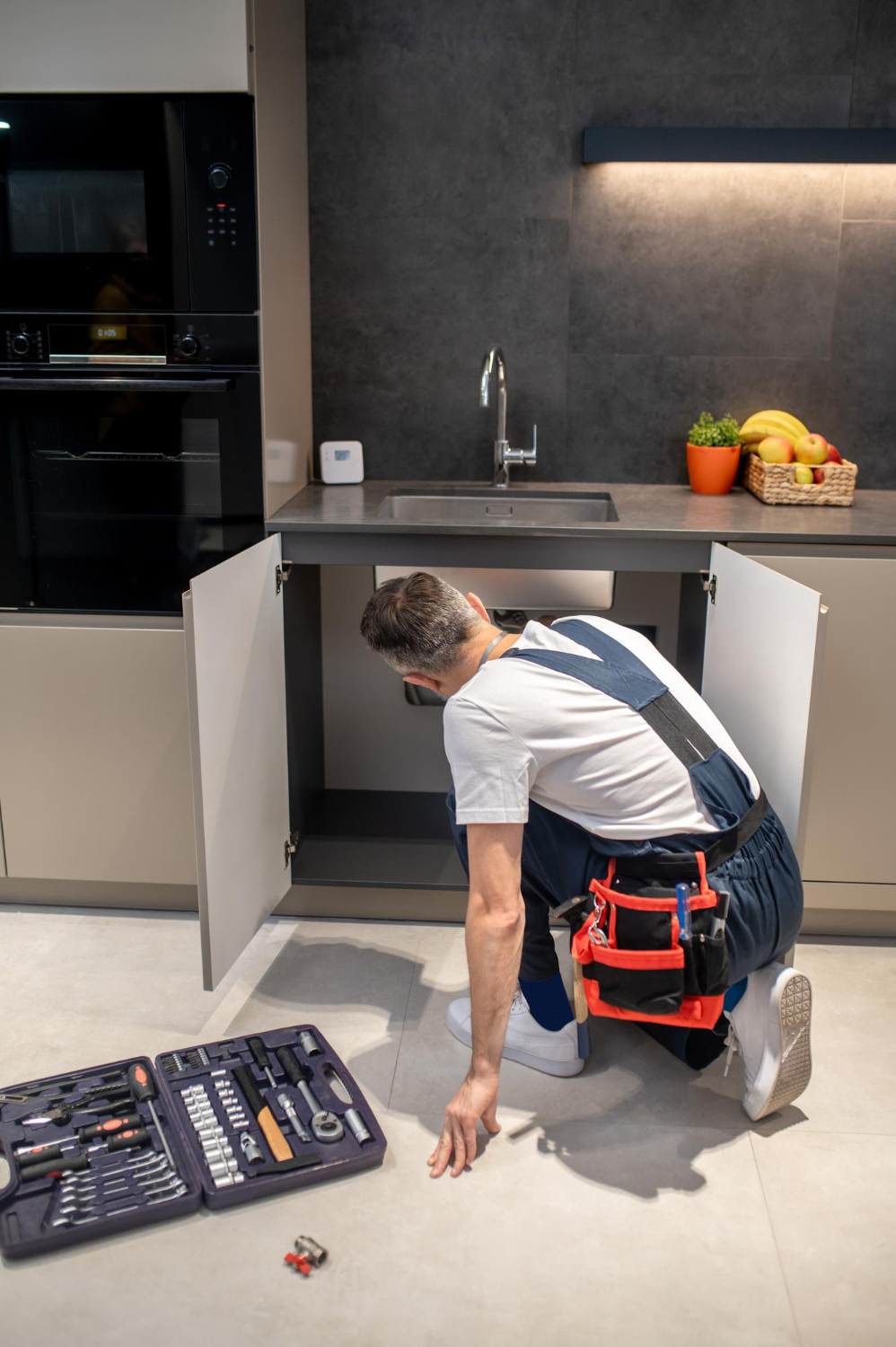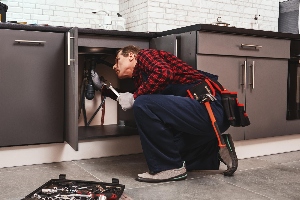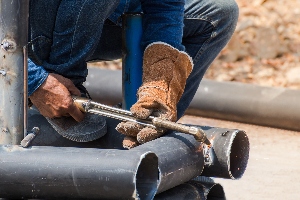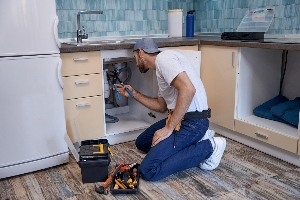Kitchen sink problems happen in every home. A leaky drain or slow water flow can disrupt your daily routine and cause bigger issues if you wait too long to fix them.
Most kitchen sink leaks and slow drains can be fixed with simple tools and basic plumbing knowledge, saving you hundreds of dollars in professional repair costs. These common problems often come from loose connections, grease buildup, or blocked pipes that we can tackle ourselves.
We'll show you how to identify what's causing your kitchen sink issues and walk you through proven repair methods. You'll also learn maintenance tips to prevent future problems and understand when it's time to call a professional plumber instead of doing the work yourself.
Let’s break down the key points you should consider:
- Common kitchen plumbing issues homeowners face
- Effective solutions for kitchen drain repair
- Kitchen plumbing maintenance tips that prevent bigger problems
- Costs of common kitchen plumbing repairs
- When to call in a plumbing professional
Keep reading to learn how to handle common kitchen plumbing repairs like replacing a sink drain or clearing clogs before they cause serious damage.
Common kitchen plumbing issues homeowners face
Kitchen plumbing problems typically fall into three main categories: drainage issues that create slow-flowing or blocked sinks, leaks that can cause water damage, and warning signs that indicate repairs are needed before major failures occur.
What causes a slow kitchen drain or frequent clogs
Food particles are the biggest culprit behind kitchen drain problems. Grease and oil solidify in pipes and trap other debris.
Common causes of slow drains include:
- Grease buildup from cooking oils and fats
- Food scraps that slip past garbage disposals
- Soap residue mixing with food particles
- Coffee grounds and small food bits
EPA guidance for kitchen sink maintenance emphasizes disposing of fats, oils, and grease in sealed containers rather than washing them down the drain, which helps prevent clogs and septic system damage.
We see clogs form gradually over time. Small amounts of grease coat pipe walls and catch food particles. This creates a sticky layer that grows thicker with each use.
Items that commonly cause clogs:
- Pasta and rice (they expand when wet)
- Eggshells and vegetable peels
- Meat fats and cooking oils
- Starchy foods like potato skins
The main drain line connects to other pipes in your home. When kitchen drains move slowly, the problem usually stays in the kitchen branch. This makes kitchen clogs easier to fix than main sewer line issues.
Why sink leaks often go unnoticed
Most sink leaks start small and happen under the sink where we don't look often. Water drips slowly at first and gets absorbed by items stored in the cabinet.
Hidden leak locations:
- Under-sink pipe connections
- Faucet base where it meets the sink
- Garbage disposal mounting area
- Supply line connections to shut-off valves
We often miss early warning signs because leaks develop gradually. A small drip might only create a tiny puddle that dries up between uses. Cabinet doors hide the problem area from daily view.
Signs of hidden leaks:
- Musty smells from under the sink
- Water stains on cabinet floors
- Warped or soft cabinet wood
- Higher than normal water bills
Kitchen sinks get heavy use during meal prep and cleanup. This constant use puts stress on connections and seals. Temperature changes from hot and cold water also cause pipes to expand and contract.
Signs your kitchen plumbing needs repair now
Water backing up in your sink during normal use signals a serious drainage problem. This happens when clogs block the main drain line completely.
Immediate repair warning signs:
- Water bubbling up from the garbage disposal
- Sink draining into the dishwasher
- Multiple drains backing up at once
- Sewage smells coming from the sink
Low water pressure from your kitchen faucet often means mineral buildup or damaged internal parts. This problem gets worse over time and won't fix itself.
Critical pressure problems:
- Weak water flow from faucet
- Uneven spray patterns
- Water coming out in spurts
- Temperature control issues
We recommend calling a plumber immediately if you see water pooling around the sink base or cabinet floor. Active leaks can damage flooring and create mold problems quickly.
Unusual sounds like gurgling or whistling from pipes indicate air in the system or partial blockages. These sounds often happen before complete failures occur.
Effective solutions for kitchen drain repair
Kitchen drain repair involves three main approaches: replacing damaged drain components, clearing blockages, and identifying when professional help is needed. Each solution targets different problems in your plumbing system.
Replacing a sink drain: What to expect
Drain replacement becomes necessary when the existing drain assembly is cracked, corroded, or leaking from multiple connection points. We typically see this in older homes where metal drains have deteriorated over time.
Tools needed for drain replacement:
- Plumber's putty or silicone sealant
- Pipe wrench
- Plunger-style drain removal tool
- New drain assembly
The process involves removing the old drain from underneath the sink. We disconnect the P-trap first, then unscrew the drain assembly from the sink basin.
Most homeowners can complete this kitchen drain repair in 2-3 hours. The new drain connects to existing pipes in most cases.
Cost expectations:
- Basic drain assembly: $15-30
- Professional installation: $150-300
- DIY completion time: 2-3 hours
We recommend checking local plumbing codes before starting. Some areas require permits for drain replacement work.
Clearing clogs vs. fixing structural drain issues
Clog removal differs significantly from structural repairs in your plumbing system. Simple clogs respond to basic clearing methods, while structural issues require different solutions.
Common clog removal methods:
- Hot water and dish soap flush
- Baking soda and vinegar treatment
- Plunger for minor blockages
- Drain snake for deeper clogs
We start with the gentlest method first. Pour half a cup of dish soap down the drain, followed by hot water. This dissolves grease buildup effectively.
For stubborn clogs, we use baking soda and vinegar. Pour one cup of baking soda, then one cup of vinegar. Wait 30 minutes before flushing with hot water.
Structural issues require different approaches:
- Improper pipe slope
- Damaged P-trap connections
- Venting problems in the plumbing system
- Corroded pipe sections
These problems need pipe adjustments or replacements rather than simple clog removal techniques.
When professional kitchen drain repair is the best call
We recommend calling professionals when drain problems persist after basic repairs or involve complex plumbing system issues. Multiple failed attempts at clog removal often indicate deeper structural problems.
Signs you need professional help:
- Water backing up into adjacent sinks
- Sewage odors from the drain
- Multiple drain locations affected
- Gurgling sounds throughout the house
Professional plumbers have specialized tools like motorized drain snakes and camera inspection equipment. These tools identify problems we cannot see or reach with basic methods.
Complex repairs requiring professionals:
- Main drain line blockages
- Pipe rerouting or replacement
- Code compliance issues
- Garbage disposal integration problems
Professional kitchen drain repair costs range from $200-800 depending on the problem complexity. We save money in the long run by avoiding repeated failed attempts and potential water damage.
Emergency situations like sewage backups require immediate professional attention regardless of cost considerations.
Kitchen plumbing maintenance tips that prevent bigger problems
Regular maintenance stops small kitchen plumbing issues from becoming expensive repairs. Simple daily habits and smart inspection schedules protect your pipes and drains from damage.
Daily habits to keep your drains clear
We recommend scraping all food scraps into the trash before washing dishes. Even small bits of food can build up in pipes over time.
Never pour these items down your drain:
- Grease, oil, or cooking fat
- Coffee grounds
- Rice, pasta, or other starches
- Eggshells or bones
Run cold water for 15 seconds after using your garbage disposal. This flushes food particles through the pipes completely.
Pour a pot of hot water down your drain once a week. The heat helps dissolve soap buildup and small grease deposits.
Keep a mesh strainer in your sink to catch food particles. Clean it after each use to prevent clogs from forming.
How often to inspect under-sink plumbing
Check under your sink every three months for signs of problems. Look for water spots, rust stains, or damp areas around pipes.
What to examine during each inspection:
- Pipe connections for loose fittings
- Water supply lines for cracks or bulges
- Drain pipes for leaks or corrosion
- Cabinet floor for water damage
Test your faucet aerators every four months. Remove them and clean out mineral deposits that block water flow.
We suggest having a professional drain cleaning done once a year. This removes buildup that regular maintenance cannot reach.
Check your garbage disposal monthly by running it with cold water. Listen for unusual sounds that might signal worn parts.
Avoiding DIY fixes that cause more harm than good
Some repairs require professional help to avoid making problems worse. We see many homeowners create bigger issues by attempting complex fixes.
Never attempt these repairs yourself:
- Moving or replacing supply lines
- Installing new shut-off valves
- Fixing major pipe leaks
- Replacing garbage disposals
Using chemical drain cleaners can damage your pipes over time. These products eat away at metal and plastic components. The EPA advises against using chemical drain openers for clogged drains because they can erode pipe walls and rubber seals; instead, it recommends safer alternatives like boiling water or a drain snake .
Over-tightening pipe connections is a common DIY mistake. This can crack fittings and create new leaks.
Call a plumber if you find multiple leaks or water damage. These problems often indicate larger issues in your plumbing system.
Simple clogs and minor faucet drips are safe for most homeowners to fix. Anything involving gas lines or major water leaks needs professional attention.
Costs of common kitchen plumbing repairs
Kitchen plumbing repairs typically range from $100 to $800 depending on the problem. Simple fixes like leaky faucets cost much less than drain replacements or major pipe work.
What you might pay to replace a sink drain
Replacing a sink drain costs between $150 and $400 for most kitchens. This price includes both parts and labor from a professional plumber.
The drain assembly itself costs $20 to $80. Basic plastic drains cost less than stainless steel or specialty finishes. We recommend choosing materials that match your sink.
Labor makes up most of the total cost. Plumbers charge $75 to $150 per hour for this type of work. Most drain replacements take 1 to 3 hours to complete.
Additional costs might include:
- Removing old caulk or sealant: $25-$50
- Repairing damaged pipes: $100-$300
- Installing new shut-off valves: $50-$150
Double sinks cost more because they need two drain assemblies. Expect to pay an extra $50 to $100 for the second drain.
Factors that affect pricing on kitchen plumbing jobs
Several factors change how much we pay for kitchen plumbing repairs. Understanding these helps us budget better.
Location matters most. Plumbers in big cities charge more than those in small towns. Urban areas often have rates 30% to 50% higher than rural places.
Time of service affects pricing. Emergency calls cost $200 to $500 extra. Weekend and holiday work adds 25% to 50% to normal rates.
Complexity increases costs. Simple faucet repairs cost $125 to $350. Major pipe work runs $500 to $800 or more.
Access problems raise prices. Hard-to-reach pipes under cabinets take longer to fix. Plumbers charge more when they must remove cabinets or flooring.
Material choices impact total costs. Basic parts keep costs down. Premium finishes and specialty items add $50 to $200 to most jobs.
How to get an accurate, upfront estimate
Getting a good estimate helps us avoid surprise costs. We should always ask for written quotes before work begins.
Call multiple plumbers for quotes. Three estimates give us a good price range. This helps us spot unusually high or low bids.
Describe the problem clearly. Give specific details about what we see and hear. Mention any previous repair attempts.
Ask about all potential costs. Request estimates that include parts, labor, and any extra fees. Some plumbers charge trip fees or disposal costs.
Get estimates in writing. Written quotes protect us from price changes. Good estimates list specific parts and labor hours.
Ask about warranties. Most plumbers guarantee their work for 30 to 90 days. Parts warranties vary by manufacturer.
Schedule estimates during normal hours. Avoid emergency rates by planning ahead when possible.
When to call in a plumbing professional
Some kitchen plumbing problems need professional hands to fix them safely and correctly. A licensed plumber can handle complex repairs that might cause more damage if you try to fix them yourself.
Red flags that your repair is beyond DIY
Water backing up into multiple drains signals a main line blockage. This problem affects your whole plumbing system and needs special equipment to fix.
Gas line issues require immediate professional help. Never attempt to work on gas connections near your kitchen appliances.
Burst pipes or major leaks can flood your home quickly. Turn off the main water supply and call a plumber right away.
We recommend calling professionals when you see these warning signs:
- Water pressure drops throughout your house
- Sewage smells coming from drains
- Water damage spreading to walls or floors
- Multiple failed DIY attempts
Electrical components near water create serious safety risks. Garbage disposals and dishwasher connections need expert installation.
Benefits of hiring a licensed kitchen plumbing expert
Licensed plumbers carry insurance that protects your home from damage during repairs. They also provide warranties on their work.
Professional tools get the job done faster than basic household equipment. Drain snakes, pipe cameras, and hydro-jetting equipment clear tough blockages.
Code compliance matters for kitchen plumbing work. Licensed plumbers know local building codes and permit requirements.
We see these advantages with professional repair:
- Proper diagnosis of root problems
- Access to commercial-grade parts
- Knowledge of brand-specific appliance connections
- Long-term solutions instead of temporary fixes
Time savings add up when you factor in multiple trips to hardware stores and repeated attempts.
Why local plumbers in Greenville & Spartanburg matter
Local plumbers in Greenville and Spartanburg know regional water conditions and common pipe materials in older homes. They stock parts that work well in our area.
Response times stay shorter when your plumber works nearby. Emergency calls get faster service from local professionals.
Reputation matters in smaller communities. Local plumbers depend on word-of-mouth referrals from satisfied customers.
We prefer working with local professionals because they:
- Understand seasonal plumbing challenges
- Know reliable suppliers for quick part replacement
- Build relationships with repeat customers
- Stay familiar with neighborhood plumbing systems
Follow-up service comes easier when your plumber works in the same area. They can return quickly if problems develop later.
Conclusion
Kitchen sink plumbing problems don't have to be scary. We've shown you how to fix the most common issues with simple tools and basic skills.
Most repairs take less than 30 minutes. The key is knowing what to look for and having the right approach.
When to call a professional: If water damage has occurred, pipes are cracked, or problems keep coming back after your repairs.
Regular maintenance prevents most issues. Check connections monthly and clean drains weekly with hot water.
These simple fixes can save hundreds of dollars in repair costs. Start with the easiest solutions first, like checking loose connections or using a plunger.
Remember that most kitchen sink problems have simple causes. With patience and the right tools, we can handle these repairs ourselves.
Call One Call Plumbing today if your kitchen sink issues persist—don’t wait for minor leaks or clogs to turn into costly water damage.












